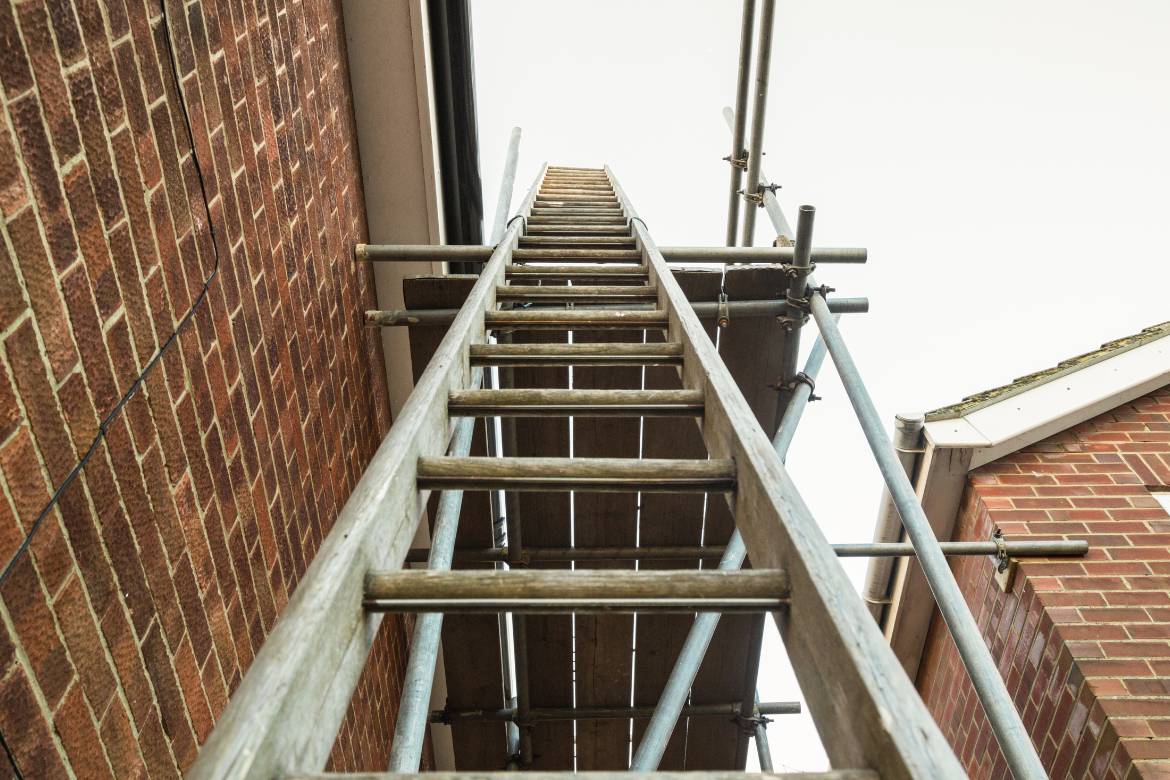3rd October, 2023
The ALARP Principle With 5 Real World Examples
ALARP stands for as low as reasonably practicable. It's written into a lot of health and safety regulations, in several different ways. But how do we apply ALARP in the real world? And what is reasonably practicable anyway? First, we need to understand the meaning of ALARP.

ALARP means as low as reasonably practicable.
As.
Low.
As.
Reasonably.
Practicable.
ALARP is a health and safety acronym for that phrase.
You will find the phrase "as low as reasonably practicable" in many health and safety regulations, in different ways.
But what does it mean? But how do we apply ALARP in the real world? What is reasonably practicable anyway? First, we need to understand the meaning of ALARP.
The definition of ALARP
ALARP is short for as low as reasonably practicable. If you read any health and safety regulations, you will often find the term so far as is reasonably practicable (SFAIRP). These two terms generally mean the same thing.
...at their core is the concept of “reasonably practicable”; this involves weighing a risk against the trouble, time and money needed to control it.
Reasonably practicable is not a specific level. It's not prescriptive, so it doesn't tell you exactly what is expected. For example, it doesn't say, as low as 2 accidents per year. Or, as low as 7 sick days per month.
What is reasonably practicable for one risk might not be sufficient for another.
But reasonably practicable was defined by the Court of Appeal in 1949 as being anything that is not grossly disproportionate.

To spend £200k to protect a worker from a very small chance of tripping over could be considered grossly disproportionate. Especially when there may be cheaper and equally effective control measures you can use.
But to spend that same amount on protecting workers from a risk that could prove fatal? That would be proportionate.
The ALARP Principle
As low as is reasonably practicable (ALARP) is the level to which risk should be controlled.
We might not be able to eliminate all risks. Risks are a part of life, after all. But risk must be controlled, especially when it comes to health and safety. Lives depend on it.
Time, money and resources are needed to reduce risks. The HSE recognise this. You are not expected to spend infinite resources and money on eliminating all risks. How could you stay in business if that was the case? You would never make a profit, forever chasing the impossible - zero risks.
But your business also relies on its team. And if you put your team in danger, it puts your business in danger too.

And health and safety isn't a money pit. Good health and safety practices can save you money, and be a great investment for your business.
It's much better to spend some time and money on protecting your workforce now, rather than the risk costing you 10x that amount in loss of staff, sickness, loss of productivity, and fines. This is what can happen if a risk isn't controlled, ALARP.
As low as reasonably practicable.
So what is reasonably practicable?
Reasonably practicable is a narrower term than ‘physically possible’ and implies that a computation must be made... in which the quantum of risk is placed in one scale and the sacrifice involved in the measures necessary for averting the risk (whether in time, trouble or money) is placed in the other and that, if it be shown that there is a great disproportion between them – the risk being insignificant in relation to the sacrifice – the person upon whom the obligation is imposed discharges the onus which is upon him.
Just because a control measure is expensive or will take time to put in place, doesn't mean that you wouldn't be expected to do it. For high risks, it would certainly be reasonable to spend a high amount of effort to control it.
To decide if ALARP has been reached, you should consider the following:
- Has good practice been followed?
- Is there any more that can be done to reduce the risk?
- If yes, are further controls reasonably practicable?
To decide if further controls are reasonably practicable, you can look at:
- The cost and time to implement them.
- The level of risk that will be reduced by implementing them.
This compares the risk with the sacrifice involved in further reducing it. If the costs of further controls are high, but they will only reduce the risk a small amount, then they may be grossly disproportionate. ALARP has been reached. However, if further controls can make significant risk reductions, or are cheap and easy to implement, they will need to be introduced to reach ALARP.
ALARP Examples
Deciding what is reasonably practicable can be a tricky problem to solve. No one can tell you exactly what is reasonable, and what isn't. You have to decide for yourself.
But there are often guidance and best practice measures you can follow for common activities. So you are not completely on your own!
You should be closer to knowing what to aim for now, but you were promised some real-life examples. So let's look at some examples that have been implemented in the real world, and some examples from inside the courts.
Example 1
Our first example goes back to the Edwards v. National Coal Board case in 1949.
We start with this example because it defined the meaning of reasonably practicable, which is the cornerstone of ALARP.
In this example, it was determined to be reasonably practicable to shore up the roadways that required it to prevent collapse. Unfortunately, it hadn't been done because the National Coal Board thought it was too expensive.
Edwards died when the mine roadway collapsed.
Example 2
For our second example, let's look at dust suppression. Particularly water jet suppression.
Dust might just be seen as a nuisance by some, but when cutting, sawing or drilling concrete, rock and other building materials, the dust can be hazardous. Silica dust kills around 800 people in the UK each year.
With that level of risk, it's proportionate and good practice to control dust exposure.
Is supplying a dust mask alone ALARP?

A dust mask might protect the worker, but dust spreads. What about other workers nearby? What about members of the public?
Other control measures, like water jet dust suppression, can combat dust at the source. They are also relatively cheap and easy to implement and significantly reduce the risk further.
Example 3
In 2018, a manufacturer was prosecuted and fined over £80,000 for failing to reduce risks ALARP.
In 2017, a worker was crushed and broke 14 ribs when a forklift truck hit a pile of roof trusses which fell on him. The courts found that controls including safe methods of delivering work materials, training and suitable supervision could have prevented the accident.
Prosecution results due to the failure to discharge the duty to which it is subjected by virtue of Section 2(1) of HSW Act ensure, so far as is reasonably practicable, the safety at work, including safety from the risks associated with the movement of vehicles in the truss plant, of all its employees...
Example 4
For another real-world example, let's look at ladder use.
Many contractors don't like ladders being used on their sites. It's not because ladders are banned (they aren't), but because there are often other - and safer - alternatives.
Ladders are not safe working platforms. So, if you are working off a ladder to fix something at height, is the risk ALARP? As low as reasonably practicable? I don't think so.
For this reason, a ladder should only be used for access and very short-duration work (30 minutes max). For anything that requires longer or repetitive work at height, a tower scaffold, MEWP, or fixed scaffold, might be more appropriate.
A proper working platform will significantly reduce the risk, it's good practice, and therefore, it's reasonably practicable.

Example 5
In 2018 a steelwork contractor was fined £150,000 when a worker fell through a roof and fractured his spine.
The courts found that alternative access equipment should have been provided to reduce the risk ALARP, and to avoid the need for the work to be carried out on the roof of the building.
Failure to properly plan the work at height or ensure that it was carried out in a manner which was so far as is reasonably practicable safe.
Use the free risk calculator to assess risk in your workplace. And use our risk assessment templates to help you control risks ALARP for your activities.
This article was written by Emma at HASpod. Emma has over 10 years experience in health and safety and BSc (Hons) Construction Management. She is NEBOSH qualified and Tech IOSH.
Better health and safety...
We are here to help you and your business put safety in everything.
Learn MoreRecent posts like this...

HSE Fee For Intervention Charges Explained
FFI stands for 'fee for intervention', which was introduced under the Health and Safety (Fees) Regulations 2012. FFI aims to recover the HSE's costs, including inspection, investigation and enforcement action, charging businesses that are in breach of health and safety regulations.
Read Post
How To Plan For Better Health And Safety At Work
If you want better health and safety, you need to plan for it. And who doesn't want to stay safer and have fewer accidents and ill health in their workplace? In this blog post, we look at how to plan for better health and safety at work.
Read Post
No Injuries, No Health And Safety Problems!?
It's been over a year since the last injury in your workplace. But just because you haven't had any accidents doesn't mean you are safe or that your health and safety performance is good. Your accident reporting system might just be hiding the truth. No injuries, no problems!? Don't count on it.
Read Post